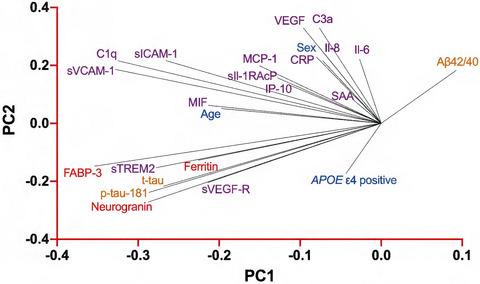当前位置:
X-MOL 学术
›
J. Neurochem.
›
论文详情
Our official English website, www.x-mol.net, welcomes your feedback! (Note: you will need to create a separate account there.)
Interrelations of Alzheimer´s disease candidate biomarkers neurogranin, fatty acid-binding protein 3 and ferritin to neurodegeneration and neuroinflammation
Journal of Neurochemistry ( IF 4.7 ) Pub Date : 2020-09-07 , DOI: 10.1111/jnc.15175 Frederic Brosseron 1, 2 , Kilian Kleemann 3 , Carl-Christian Kolbe 4 , Francesco Santarelli 1, 2 , Sergio Castro-Gomez 2 , Pawel Tacik 2 , Eicke Latz 1, 4 , Frank Jessen 1, 5 , Michael T Heneka 1, 2
Journal of Neurochemistry ( IF 4.7 ) Pub Date : 2020-09-07 , DOI: 10.1111/jnc.15175 Frederic Brosseron 1, 2 , Kilian Kleemann 3 , Carl-Christian Kolbe 4 , Francesco Santarelli 1, 2 , Sergio Castro-Gomez 2 , Pawel Tacik 2 , Eicke Latz 1, 4 , Frank Jessen 1, 5 , Michael T Heneka 1, 2
Affiliation

|
There is growing evidence that promising biomarkers of inflammation in Alzheimer´s disease (AD) and other neurodegenerative diseases correlate strongest to levels of tau or neurofilament, indicating an inflammatory response to neuronal damage or death. To test this hypothesis, we investigated three AD candidate markers (ferritin, fatty acid binding protein 3 (FABP-3), and neurogranin) in interrelation to established AD and inflammatory protein markers. We further aimed to determine if such interrelations would be evident in pathological subjects only or also under non-pathological circumstances. Cerebrospinal fluid levels of the three proteins were quantified in samples from the University Clinic of Bonn (UKB) Department of Neurodegenerative Diseases & Geriatric Psychiatry, Germany. Data were analyzed based on clinical or biomarker-defined stratification of subjects with adjustment for covariates age, sex, and APOE status. Levels of ferritin, FABP-3 and neurogranin were elevated in subjects with pathological levels of t-tau independent of beta-amyloid status. The three markers correlated with each other, tau isoforms, age, and those inflammatory markers previously described as related to neurodegeneration, predominantly sTREM2, macrophage migration inhibitory factor, soluble vascular endothelial growth factor receptor, soluble vascular cell adhesion molecule 1 (sVCAM-1), and C1q. These interrelations existed in subjects with pathological and sub-pathological tau levels, in particular for FABP-3 and neurogranin. Relations to ferritin were independent of absolute levels of tau, too, but showed differing trajectories between pathological and non-pathological subjects. A specific set of inflammatory markers is highly related to markers of neuronal damage such as tau, neurogranin, or FABP-3. These proteins could be used as readouts of the inflammatory response during the neurodegeneration phase of AD.
中文翻译:

阿尔茨海默病候选生物标志物神经颗粒蛋白、脂肪酸结合蛋白 3 和铁蛋白与神经变性和神经炎症的相互关系
越来越多的证据表明,阿尔茨海默病 (AD) 和其他神经退行性疾病中的炎症生物标志物与 tau 蛋白或神经丝水平的相关性最强,表明对神经元损伤或死亡的炎症反应。为了验证这一假设,我们研究了三种 AD 候选标记物(铁蛋白、脂肪酸结合蛋白 3 (FABP-3) 和神经颗粒蛋白)与已建立的 AD 和炎症蛋白标记物的相互关系。我们进一步旨在确定这种相互关系是否仅在病理受试者中或在非病理情况下也很明显。在来自德国波恩大学诊所 (UKB) 神经退行性疾病和老年精神病学系的样本中量化了这三种蛋白质的脑脊液水平。载脂蛋白E地位。铁蛋白、FABP-3 和神经颗粒蛋白的水平在具有 t-tau 病理水平的受试者中升高,与 β-淀粉样蛋白状态无关。三个标记相互关联,tau 异构体、年龄和之前描述的与神经变性相关的炎症标记,主要是 sTREM2、巨噬细胞迁移抑制因子、可溶性血管内皮生长因子受体、可溶性血管细胞粘附分子 1 (sVCAM-1) ,和 C1q。这些相互关系存在于具有病理性和亚病理性 tau 水平的受试者中,尤其是 FABP-3 和神经颗粒蛋白。与铁蛋白的关系也与 tau 的绝对水平无关,但在病理和非病理受试者之间显示出不同的轨迹。一组特定的炎症标志物与神经元损伤的标志物高度相关,如 tau、神经颗粒蛋白或 FABP-3。这些蛋白质可用作 AD 神经变性阶段炎症反应的读数。
更新日期:2020-09-07
中文翻译:

阿尔茨海默病候选生物标志物神经颗粒蛋白、脂肪酸结合蛋白 3 和铁蛋白与神经变性和神经炎症的相互关系
越来越多的证据表明,阿尔茨海默病 (AD) 和其他神经退行性疾病中的炎症生物标志物与 tau 蛋白或神经丝水平的相关性最强,表明对神经元损伤或死亡的炎症反应。为了验证这一假设,我们研究了三种 AD 候选标记物(铁蛋白、脂肪酸结合蛋白 3 (FABP-3) 和神经颗粒蛋白)与已建立的 AD 和炎症蛋白标记物的相互关系。我们进一步旨在确定这种相互关系是否仅在病理受试者中或在非病理情况下也很明显。在来自德国波恩大学诊所 (UKB) 神经退行性疾病和老年精神病学系的样本中量化了这三种蛋白质的脑脊液水平。载脂蛋白E地位。铁蛋白、FABP-3 和神经颗粒蛋白的水平在具有 t-tau 病理水平的受试者中升高,与 β-淀粉样蛋白状态无关。三个标记相互关联,tau 异构体、年龄和之前描述的与神经变性相关的炎症标记,主要是 sTREM2、巨噬细胞迁移抑制因子、可溶性血管内皮生长因子受体、可溶性血管细胞粘附分子 1 (sVCAM-1) ,和 C1q。这些相互关系存在于具有病理性和亚病理性 tau 水平的受试者中,尤其是 FABP-3 和神经颗粒蛋白。与铁蛋白的关系也与 tau 的绝对水平无关,但在病理和非病理受试者之间显示出不同的轨迹。一组特定的炎症标志物与神经元损伤的标志物高度相关,如 tau、神经颗粒蛋白或 FABP-3。这些蛋白质可用作 AD 神经变性阶段炎症反应的读数。



























 京公网安备 11010802027423号
京公网安备 11010802027423号